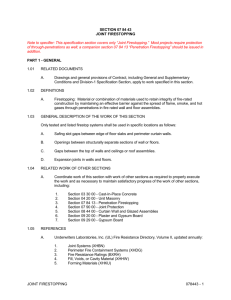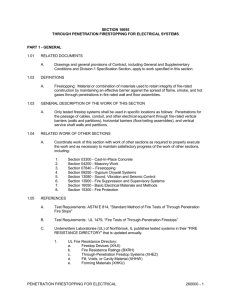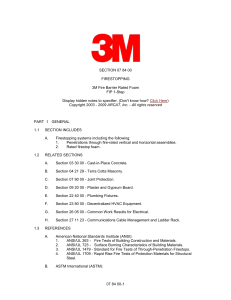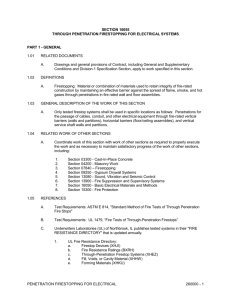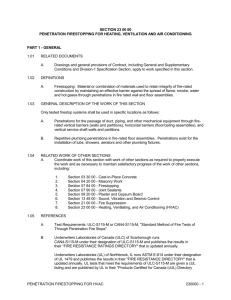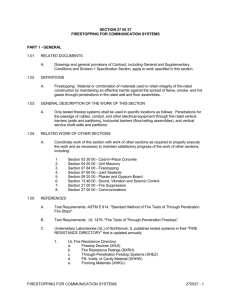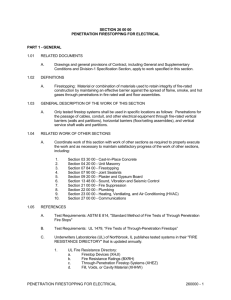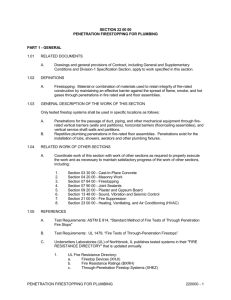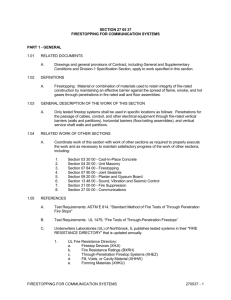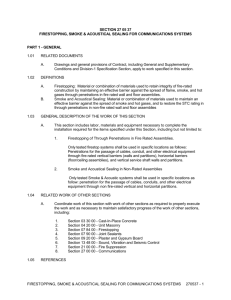SECTION 16055 - Hilti Canada
advertisement
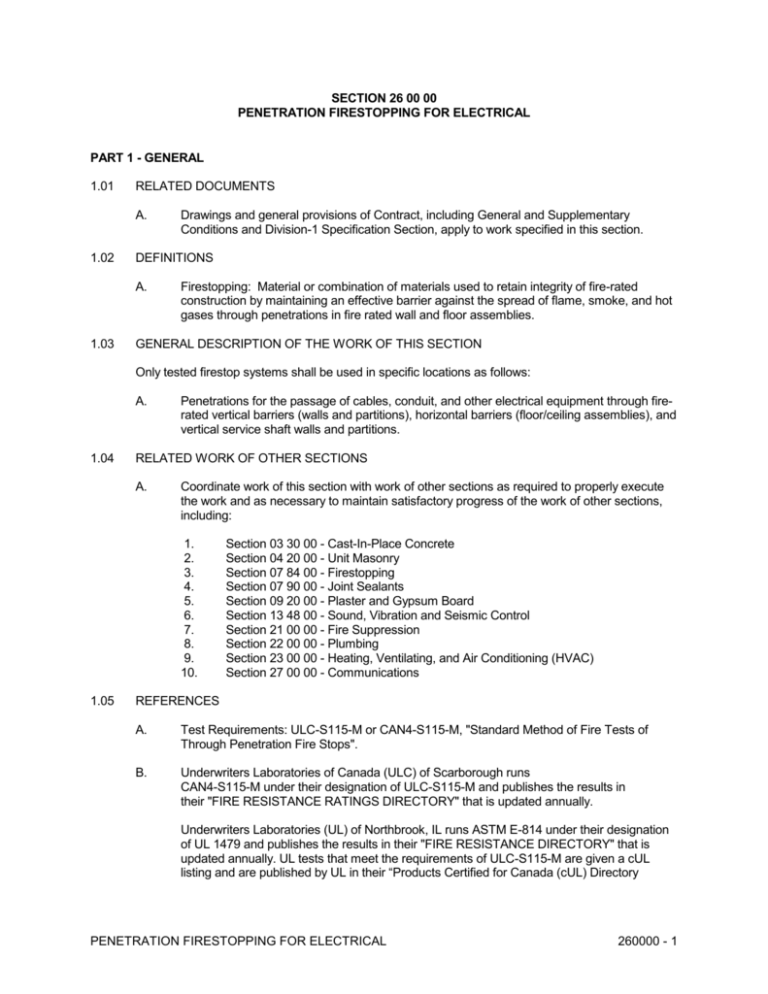
SECTION 26 00 00 PENETRATION FIRESTOPPING FOR ELECTRICAL PART 1 - GENERAL 1.01 RELATED DOCUMENTS A. 1.02 DEFINITIONS A. 1.03 Drawings and general provisions of Contract, including General and Supplementary Conditions and Division-1 Specification Section, apply to work specified in this section. Firestopping: Material or combination of materials used to retain integrity of fire-rated construction by maintaining an effective barrier against the spread of flame, smoke, and hot gases through penetrations in fire rated wall and floor assemblies. GENERAL DESCRIPTION OF THE WORK OF THIS SECTION Only tested firestop systems shall be used in specific locations as follows: A. 1.04 Penetrations for the passage of cables, conduit, and other electrical equipment through firerated vertical barriers (walls and partitions), horizontal barriers (floor/ceiling assemblies), and vertical service shaft walls and partitions. RELATED WORK OF OTHER SECTIONS A. Coordinate work of this section with work of other sections as required to properly execute the work and as necessary to maintain satisfactory progress of the work of other sections, including: 1. 2. 3. 4. 5. 6. 7. 8. 9. 10. 1.05 Section 03 30 00 - Cast-In-Place Concrete Section 04 20 00 - Unit Masonry Section 07 84 00 - Firestopping Section 07 90 00 - Joint Sealants Section 09 20 00 - Plaster and Gypsum Board Section 13 48 00 - Sound, Vibration and Seismic Control Section 21 00 00 - Fire Suppression Section 22 00 00 - Plumbing Section 23 00 00 - Heating, Ventilating, and Air Conditioning (HVAC) Section 27 00 00 - Communications REFERENCES A. Test Requirements: ULC-S115-M or CAN4-S115-M, "Standard Method of Fire Tests of Through Penetration Fire Stops". B. Underwriters Laboratories of Canada (ULC) of Scarborough runs CAN4-S115-M under their designation of ULC-S115-M and publishes the results in their "FIRE RESISTANCE RATINGS DIRECTORY" that is updated annually. Underwriters Laboratories (UL) of Northbrook, IL runs ASTM E-814 under their designation of UL 1479 and publishes the results in their "FIRE RESISTANCE DIRECTORY" that is updated annually. UL tests that meet the requirements of ULC-S115-M are given a cUL listing and are published by UL in their “Products Certified for Canada (cUL) Directory PENETRATION FIRESTOPPING FOR ELECTRICAL 260000 - 1 1.06 1.07 C. International Firestop Council Guidelines for Evaluating Firestop Systems Engineering Judgments D. Inspection Requirements: ASTM E 2174 – 01, “Standard Practice for On-site Inspection of Installed Fire Stops.” E. CAN/ULC-S102-M, Standard Test Method for Surface Burning Characteristics of Building Materials. F. All major building codes: NBC, OBC, BCBC, and ABC. (Note to specifier: Retain or delete building codes listed above as applicable) G. NFPA 101 - Life Safety Code H. Canadian Electrical Code QUALITY ASSURANCE A. A manufacturer's direct representative (not distributor or agent) to be on-site during initial installation of firestop systems to train appropriate contractor personnel in proper selection and installation procedures. This will be done per manufacturer's written recommendations published in their literature and drawing details. B. Firestop System installation must meet requirements of CAN4-S115-M or ULC S-115-M tested assemblies that provide a fire rating as shown in Section 2.03 Clauses K & L below. C. Proposed firestop materials and methods shall conform to applicable governing codes having local jurisdiction. D. Firestop Systems do not reestablish the structural integrity of load bearing partitions/assemblies, or support live loads and traffic. Installer shall consult the structural engineer prior to penetrating any load bearing assembly. E. For those firestop applications that exist for which no ULC or cUL tested system is available through a manufacturer, a manufacturer's engineering judgment derived from similar UL system designs or other tests will be submitted to local authorities having jurisdiction for their review and approval prior to installation. Engineer judgment drawings must follow requirements set forth by the International Firestop Council. SUBMITTALS A. Submit Product Data: Manufacturer’s specifications and technical data for each material including the composition and limitations, documentation of ULC or cUL firestop systems to be used and manufacturer's installation instructions to comply with Section 01 33 00. B. Manufacturer's engineering judgment identification number and drawing details when no UL system is available for an application. Engineer judgment must include both project name and contractor’s name who will install firestop system as described in drawing. C. Submit material safety data sheets provided with product delivered to job-site. D. Submit documentation showing products are formaldehyde free and low in VOC content in accordance with LEED requirements. E. Submit a complete firestopping and smokeseal schedule within fourteen (14) days of award of Contract to the Consultant for review. Schedule is to include complete details, cut sheets, PENETRATION FIRESTOPPING FOR ELECTRICAL 260000 - 2 system descriptions and location of each proposed firestopping & smokeseal application. Alter schedule as recommended by the Consultant and resubmit as required. 1.08 INSTALLER QUALIFICATIONS A. 1.09 1.10 Engage an experienced Installer who is certified, licensed, or otherwise qualified by the firestopping manufacturer as having been provided the necessary training to install manufacturer’s products per specified requirements. A manufacturer’s willingness to sell its firestopping products to the Contractor or to an Installer engaged by the Contractor does not in itself confer qualification on the buyer. DELIVERY, STORAGE, AND HANDLING A. Deliver materials undamaged in manufacturer's clearly labeled, unopened containers, identified with brand, type, and ULC or cUL label where applicable. B. Coordinate delivery of materials with scheduled installation date to allow minimum storage time at job-site. C. Store materials under cover and protect from weather and damage in compliance with manufacturer's requirements, including temperature limitations. D. Comply with recommended procedures, precautions or remedies described in material safety data sheets as applicable. E. Do not use damaged or expired materials. PROJECT CONDITIONS A. Do not use materials that contain flammable solvents. B. Scheduling 1. Schedule installation of CAST IN PLACE firestop devices after completion of floor formwork, metal form deck, or composite deck but before placement of concrete. 2. Schedule installation of other firestopping materials after completion of penetrating item installation but prior to covering or concealing of openings. C. Verify existing conditions and substrates before starting work. Correct unsatisfactory conditions before proceeding. D. Weather conditions: Do not proceed with installation of firestop materials when temperatures exceed the manufacturer's recommended limitations for installation printed on product label and product data sheet. E. During installation, provide masking and drop cloths to prevent firestopping materials from contaminating any adjacent surfaces. PART 2 - PRODUCTS 2.01 FIRESTOPPING, GENERAL A. Provide firestopping composed of components that are compatible with each other, the substrates forming openings, and the items, if any, penetrating the firestopping under PENETRATION FIRESTOPPING FOR ELECTRICAL 260000 - 3 conditions of service and application, as demonstrated by the firestopping manufacturer based on testing and field experience. B. Provide components for each firestopping system that are needed to install fill material. Use only components specified by the firestopping manufacturer and approved by the qualified testing agency for the designated fire-resistance-rated systems. C. Firestopping Materials are either “cast-in-place” (integral with concrete placement) or “post installed.” Provide cast-in-place firestop devices prior to concrete placement. D. Penetrations in Smoke Barriers: Provide firestopping with ratings determined in accordance with ULC S115. 1. E. 2.02 Mold Resistance: Provide penetration firestoppping with mold and mildew resistance rating of 0 as determined by ASTM G21. ACCEPTABLE MANUFACTURERS A. 2.03 L-Rating: Not exceeding 5.0 cfm/sq. ft. of penetration opening at both ambient and elevated temperatures. Subject to compliance with through penetration firestop systems listed in the U.L.C Fire Resistance Directory – Volume III or UL Products Certified for Canada (cUL) Directory, provide products of the following manufacturers as identified below: 1. Hilti (Canada) Corporation, Mississauga, Ontario 1-800-363-4458 www.ca.hilti.com 2. Provide products from the above acceptable manufacturer; no substitutions will be accepted. MATERIALS A. Use only firestop products that have been ULC or cUL tested for specific fire-rated construction conditions conforming to construction assembly type, penetrating item type, annular space requirements, and fire-rating involved for each separate instance. B. Cast-in place firestop devices are installed prior to concrete placement for use with noncombustible and combustible plastic pipe (closed and open piping systems), or electrical cable bundles, penetrating concrete floors, the following products are acceptable: 1. 2. 3. 4. C. Hilti Cast-In Place Firestop Device (CP 680-P) for use with combustible penetrants. Hilti Cast-In Place Firestop Device (CP 680-M) for use with noncombustible penetrants. Hilti Speed Sleeve (CP 653) for use with cable penetrations. Hilti Firestop Drop-In Device (CFS-DID) for use with noncombustible and combustible penetrants. Sealants, foams or caulking materials for use with non-combustible items including rigid steel conduit and electrical metallic tubing (EMT), the following products are acceptable: 1. 2. 3. 4. Hilti Intumescent Firestop Sealant (FS-ONE MAX) Hilti Self Leveling Firestop Sealant (CP 604) Hilti Fire Foam (CP 620) Hilti Flexible Firestop Sealant (CP 606) PENETRATION FIRESTOPPING FOR ELECTRICAL 260000 - 4 5. D. Intumescent sealants or caulking materials for use with combustible items (penetrants consumed by high heat and flame) including PVC jacketed, flexible cable or cable bundles and plastic pipe, the following products are acceptable: 1. E. Hilti Firestop Mortar (CP 637) Hilti Firestop Block (CFS-BL) Hilti Fire Foam (CP 620) Hilti Firestop Board (CP 675T) Non curing, re-penetrable materials used for large size/complex penetrations made to accommodate cable trays, multiple steel and copper pipes, electrical busways in raceways, the following products are acceptable: 1. 2. J. Hilti Firestop Putty Pad (CP 617) Hilti Firestop Box Insert Materials used for large size/complex penetrations made to accommodate cable trays, multiple steel and copper pipes, electrical busways in raceways, the following products are acceptable: 1. 2. 3. 4. I. Hilti Firestop Putty Stick (CP 618) Hilti Firestop Plug (CFS-PL) Wall opening protective materials for use with U.L.C or cUL listed metallic and specified nonmetallic outlet boxes, the following products are acceptable: 1. 2. H. Hilti Intumescent Firestop Sealant (FS-ONE MAX) Hilti Firestop Putty Stick (CP 618) Hilti Fire Foam (CP 620) Hilti Elastomeric Firestop Sealant (CP 601s) Hilti Flexible Firestop Sealant (CP 606) Non curing, re-penetrable intumescent sealants, caulking or putty materials for use with flexible cable or cable bundles, the following products are acceptable: 1. 2. G. Hilti Intumescent Firestop Sealant (FS-ONE MAX) Foams, intumescent sealants, caulking or putty materials for use with flexible cable or cable bundles, the following products are acceptable: 1. 2. 3. 4. 5. F. Hilti Elastomeric Firestop Sealant (CP 601s) Hilti Firestop Block (CFS-BL) Hilti Firestop Board (CP 675T) For blank openings made in fire-rated wall or floor assemblies, where future penetration of pipes, conduits or cables is expected, the following products are acceptable: 1. 2. 3. Hilti CFS-BL Firestop Block (for walls and floors) Hilti CFS-PL Firestop Plug (for walls and floors) Hilti CP 680 Cast-In Place Firestop Device (for floors only) PENETRATION FIRESTOPPING FOR ELECTRICAL 260000 - 5 K. For penetrations through a Fire Separation wall provide a firestop system with a "F" Rating as determined by ULC or cUL as indicated below: Fire Resistance Rating of Separation 30 minutes 45 minutes 1 hour 1.5 hours 2 hours 3 hours 4 hours Required ULC or cUL “F” Rating of Firestopping Assembly 20 minutes 45 minutes 45 minutes 1 hour 1.5 hours 2 hours 3 hours For combustible penetrations through a Fire Separation provide a firestop system with a “F” Rating as determined by ULC or cUL which is equal to the fire resistance rating of the construction being penetrated. L. For penetrations through a Fire Wall or horizontal Fire Separation provide a firestop system with a “FT” Rating as determined by ULC or cUL which is equal to the fire resistance rating of the construction being penetrated. PART 3 - EXECUTION 3.01 PREPARATION A. 3.02 1. Verify penetrations are properly sized and in suitable condition for application of materials. 2. Surfaces to which firestop materials will be applied shall be free of dirt, grease, oil, rust, laitance, release agents, water repellents, and any other substances that may affect proper adhesion. 3. Ensure all service lines are in place, tested and acceptable to the authority having jurisdiction, prior to application of fire stopping and smoke seal. 4. Provide masking and temporary covering to prevent soiling of adjacent surfaces by firestopping materials. 5. Comply with manufacturer's recommendations for temperature and humidity conditions before, during and after installation of firestopping. 6. Do not proceed until unsatisfactory conditions have been corrected. COORDINATION A. 3.03 Verification of Conditions: Examine areas and conditions under which work is to be performed and identify conditions detrimental to proper or timely completion. Coordinate location and proper selection of cast-in-place Firestop Devices with trade responsible for the work. Ensure device is installed before placement of concrete. PREPARATION OF SURFACES PENETRATION FIRESTOPPING FOR ELECTRICAL 260000 - 6 3.04 3.05 A. Where adjacent finished surfaces are exposed, provide and maintain masking, drop cloths, and polyethylene coverings for such surfaces to protect them during work of this Section. Remove stains on adjacent surfaces as required. B. Provide complete enclosures and human protective devices when installing or mixing hazardous materials. C. Make provisions for natural ventilation during and subsequent to application of firestopping and smoke seal. In enclosed areas or areas lacing openings for natural ventilation, circulate interior air by use of temporary circulators or exhaust fans. D. Examine sizes and conditions of voids to be filled to establish correct thickness and installation of materials. E. Clean bonding surfaces of deleterious substances including dust, paint, rust, oil, grease and other foreign matter which may otherwise impair effective bonding. F. Do not apply firestops and smokeseals to surfaces previously painted or treated with sealer, curing compound, water repellent, or other coatings unless tests have been performed to ensure compatibility of materials. Remove coatings as required. G. Prepare surfaces in accordance with manufacturer's directions. H. Priming and sealing: Prime surfaces in accordance with manufacturer's directions. I. Mask where necessary to avoid spillage onto adjoining surfaces. MIXING A. Mix materials in strict accordance with manufacturer's directions. B. Ensure components are mixed thoroughly and that these components are prepared by a qualified worker. INSTALLATION A. Regulatory Requirements: Install firestop materials in accordance with ULC Fire Resistance Directory or UL Products Certified for Canada (cUL) Directory. B. Manufacturer's Instructions: Comply with manufacturer's instructions for installation of through-penetration and construction joint materials. 1. Seal all holes or voids made by penetrations to ensure an air and water resistant seal. 2. Consult with mechanical engineer, project manager, and damper manufacturer prior to installation of ULC or cUL firestop systems that might hamper the performance of fire dampers as it pertains to duct work. 3. Protect materials from damage on surfaces subjected to traffic. 4. Tool or trowel exposed surfaces to a neat uniform texture where required. 5. Remove excess compound promptly as work progresses and upon completion. PENETRATION FIRESTOPPING FOR ELECTRICAL 260000 - 7 6. 3.06 Do not cover up fire stop and smoke seal installations until they have been reviewed and accepted by the Consultant and the authority having jurisdiction. FIELD QUALITY CONTROL A. Examine sealed penetration areas to ensure proper installation before concealing or enclosing areas. B. Keep areas of work accessible until inspection by applicable code authorities. C. Inspection of through-penetration firestopping shall be performed in accordance with ASTM E 2174, “Standard Practice for On-Site Inspection of Installed Fire Stops” or other recognized standard. D. Perform under this section patching and repairing of firestopping caused by cutting or penetrating of existing firestop systems already installed by other trades. E. Install a warning card that is clearly visible adjacent to all large and medium openings that may be re-penetrated. This card should contain the following information: 12345- 3.07 3.08 Warning that the opening has being fire stop protected Indicate the fire stop system used (ULC or cUL) F rating or FT rating Fire stop product(s) used Person to contact and phone number in case of modification or new penetration of fire stop system ADJUSTING AND CLEANING A. Remove equipment, materials and debris, leaving area in undamaged, clean condition. B. Clean all surfaces adjacent to sealed holes and joints to be free of excess firestop materials and soiling as work progresses. WASTE MANAGEMENT A. Separate and recycle waste materials in accordance with Waste Management Plan as specified in Section 01 74 19, and place in designated areas for recycling. B. Place materials defined as hazardous or toxic waste in designated containers. Before disposing of containers, relieve containers of any remaining foam and pressure. Allow foam to fully cure before disposing. Never dispose of foam in a liquid state. C. Collect and separate plastic, paper packaging and corrugated cardboard in accordance with Waste Management Plan. END OF SECTION PENETRATION FIRESTOPPING FOR ELECTRICAL 260000 - 8
